Each home and its landscape should be a reflection of the people who live there. The front yard is the visitor's first impression of the home and its inhabitants. When first seen, it should be inviting and direct the guest easily to the front door. The purpose of this publication is not to be a formula for the development of the front yard, but rather a guideline to planning and making choices, along with an explanation of the basic principles involved in designing a landscape. Drawings are included to illustrate concepts but are not to be interpreted as exact designs to be copied.
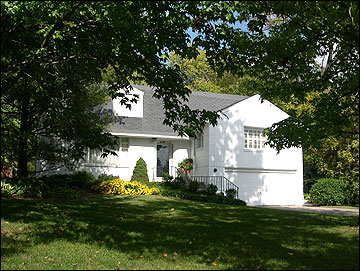 Figure 1
Figure 1
Good landscape design presents an attractive appearance and guides visitors to your door.
Site evaluation
Before purchasing any plants or other landscaping materials, indeed, before beginning to plan a design for the front yard, it is essential to evaluate what already exists. If you are building a new house on a new lot, the landscaping plan should be developed in conjunction with the house plan. If you are planning to landscape an existing front yard, then you need to take inventory of what you have, what works in the landscape and what needs to be changed. MU publication G6901, Developing the Landscape Planprovides information for making a site or base plan from which to work. Having a base plan allows you to evaluate objectively what you already have and provides an invaluable tool for creating a pleasing landscape for your front yard.
As you evaluate your site, consider the architectural style or character of your house. Is your house one story or two (or more)? Is it rustic or formal, modern or traditional? One of the goals of effective landscaping is to draw attention to the house in much the same way that an attractive frame enhances a picture. The most effective landscape shows a definite relationship to the style of the house.
The landscape should also reflect something of the character of those who live there. While it is important for the front yard to be visually compatible with the neighborhood, the choice of plants and structural materials such as paving and fences can be unique to you.
Applying basic principles to the front yard
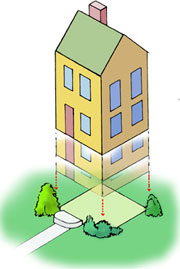
Figure 2
Traditional landscape design simply "softens" the corners of a house with small-scale plantings.
Functional principles
Landscaping should be more than just window dressing for the house. A good landscape design makes the space useful. Generally, the front yard is considered the public area of the residence. As such, this area has two primary functions: presenting an attractive appearance to the neighborhood and getting people safely and easily from the street to the front door. Depending on the residents and the area, the front yard also may be used for entertaining guests.
"Curb appeal" refers to how the front of the house looks from the street and is what most people want from a landscape design. Curb appeal increases a property's value and allows the residents to take pride in the appearance of their front yard. There are many ways to attain curb appeal through proper landscaping of the front yard.
Traditional landscaping practice is often limited to "foundation planting." This usually consists of lining the foundation of the house with a row of shrubs, usually evergreen and often pruned into geometric shapes. Larger shrubs are planted at the corners of the house to blend the sharp lines of the building into the landscape. An ornamental tree or two placed somewhere in the lawn completes this typical design (Figure 2).
Foundation planting originated in the Victorian Age as a way of hiding the unattractive high foundations that were prevalent at that time. The majority of today's homes do not have foundations that require disguising, so covering the foundation with a row of plants is no longer necessary or even desirable. Although this type of landscaping is better than an empty expanse of lawn, it lacks interest and individuality. Ideally, the front yard should contain an element of uniqueness, should relate to the architectural character of the house and to the style of the owners, while maintaining visual compatibility with the neighborhood.
Design principles
Landscaped correctly, the front yard will be attractive all four seasons of the year. Incorporating a few basic design principles will give the front yard unity, balance and interest throughout the year.
Unity
Unity in the landscape refers to the perception that all the components of the design work together in harmony. When the landscape is unified, you get a sense that everything in the landscape is part of the big picture and that all the elements work well together. Unity is achieved by selecting plants that complement each other, placing and grouping those plants effectively and repeating elements in the design.
Balance is the perception of equality in the landscape. When a front yard has several trees, shrubs or decorative elements on one side and only a few on the other, a feeling of imbalance is created in the viewer. This inequality of elements in the landscape lessens the curb appeal because it makes the area appear out of order (Figure 3 bottom).
Symmetrical asymmetrical balance
The two main types of balance used in landscape design are symmetrical balance (Figure 3 top) and asymmetrical balance (Figure 3 middle). Both create an overall sense of equality in the landscape, but in different ways. Symmetrical balance is achieved by planting and arranging all elements of the landscape in a mirror image. If a line were drawn down the middle of a space, symmetrical design would have identical placement and choice of plants and other materials on both sides. Symmetry is reasonably easy to achieve and gives a formal character to the landscape. Therefore, it is most appropriate for houses that are traditional or formal in character or symmetrical in shape (front door in the middle of the house with the exact number and placement of windows on both sides).
Asymmetrical balance is less structured. Asymmetry relies more on a "gut feeling" of balance rather than any formula or rules. One way of understanding asymmetrical balance is to imagine a large spherical weight placed on the left side of a balancing scale. To balance the right side without using an equal size weight (which would result in symmetrical balance), several smaller weights would be required. Asymmetrical balance is created by careful placement of unequal elements.
Landscape with an asymmetrical design feels more informal and casual than than symmetrical balance. It is appropriate for houses and owners whose character reflects a more relaxed attitude. Although asymmetry would appear to be the easier balance to achieve, it actually requires more thought and planning to be effective.
Interest
Interest helps create visual appeal. In general, the primary focal point in the front yard should be the entry to the house. Carefully selected specimen plants or interesting effects can be used to strengthen or reinforce the importance of the front door. Effective placement of accents increases the interest of the design and can enhance the visual appeal. However, it must be said that less is definitely more when it comes to using accents in design. Too many "attention-grabbers," whether they be plants, statuary, etc., result in a chaotic design and visual confusion.
Placement of landscape elements
Wise selection and placement of landscape materials can help fit the house into its surroundings. Good landscaping can soften the house's sharp corners and angles and help blend the man-made structure into the natural one.
Framing the house
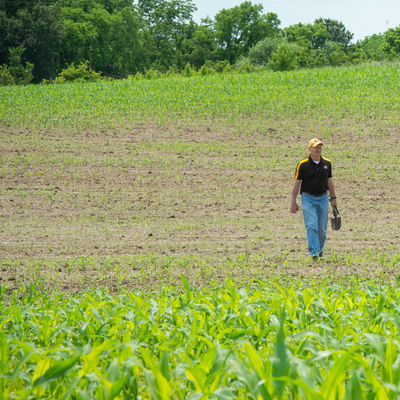 Figure 4
Figure 4
By placing progressively smaller plants near the door, you frame the house and focus attention on the entryway.
The most common approach is to design the front yard landscaping as a frame for the house. This can be done most easily by planting large trees or shrubs on both sides of the house to focus the observer's attention within its boundaries. Framing the house in this way helps to draw attention to the front door as well as the route there. By positioning progressively smaller plants closer to the door, attention is naturally drawn to the door (Figure 4).
It is important to avoid placing large plants too close to the front door. Oversized plants can hide the entrance from view and cause confusion on how to get there. A visitor should be able to identify the entryway with ease. Also, large plants positioned too close to the doorway can make the entrance feel claustrophobic and unwelcoming.
Defining borders
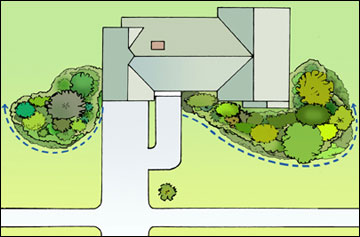
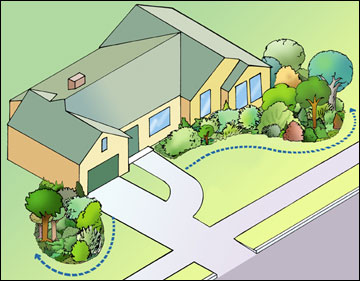 Figure 5
Figure 5
Extending plant beds from the corners of the house or increasing the paved area near an entrance can help connect the house visually with the landscape.
On many residential sites, the house is placed in or near the middle of the lot and the front yard is an open, anonymous area of lawn. Most of the landscaping is placed directly in front of the house and doesn't extend much farther out than a few feet. This openness creates a lack of unity between the house and the rest of the lawn. In addition, the lack of defined borders or edges blends one front yard into the next, leaving the driveway as the only element dividing one property from the next.
A simple way to integrate the planting close to the house with the lawn is to extend the planting bed several feet out into the yard. These beds flow most easily from the corners of the house, but need not be limited to that. Increasing the planting or paved area near the entryway can be visually effective and functional as well, as it allows several people to gather comfortably at the entrance. Extended beds may include trees and shrubs or may consist only of ground cover; any of these will help connect the house with the landscape (Figure 5).
Material selection and use
Two general categories of materials need to be considered when planning a landscape:
- Plant materials ("softscape"), primarily trees and shrubs
- Structural materials ("hardscape"), such as paving, fences and walls
Plant materials
A common landscaping mistake is to scatter an assortment of unrelated plants about the lawn. This almost always results in an unbalanced and chaotic appearance, regardless of the attractiveness of the individual plants. Instead, plants should be chosen with the overall desired effect in mind. This contributes to the sense of unity and balance.
When choosing plants, it is essential to select plants that are well suited to the environmental conditions of the site — soil type, drainage, sun and wind exposure. If plant selection is poor, then the landscape will ultimately fail. Plants growing in the wrong conditions will not develop properly and may even die. For example, placing a sun-loving plant in a shady location will result in a weak, spindly plant, and eventually the death of that plant.
Try to select plants so the front yard has year-round interest. This is done by selecting plants with more than one season of interest. An ideal deciduous (non-evergreen) plant would have attractive foliage, spring or summer flowers, good autumn color and an interesting shape or branching habit. Aim for plants that have at least two seasons of interest. Evergreen plants are good to include because they help provide structure and color in the winter months when the deciduous trees are leafless. However, aim for a good balance, as a predominance of evergreens can make the landscape appear too dark and gloomy.
Many books and software programs list and categorize plants according to their design characteristics, best uses and cultural needs. Plants native to the area are a good choice for the landscape as they have naturally adapted to local conditions and look "at home" in the landscape.
Trees
Trees are the most permanent and dominant plants in the landscape. As they are the most important plants in the front yard, careful consideration should be given to their selection and placement. Trees can be used for framing the house, providing shade, adding height and interest to a shrub bed, or screening unwanted views. To maintain a unified and balanced appearance, choose trees to be compatible with the overall look desired, i.e., formal, modern and so forth. Also, select and position trees based on their eventual size at maturity. Trees planted behind the house and visible above the roof help to soften the roofline. Large shade trees are seldom appropriate in the front yard, however, as they dwarf most houses. Even small to medium-size trees need to be placed well away from the foundation of the house. A common mistake is to plant a young tree too close to the house, where it does not have the space to develop a proper shape. Further details for using trees in the landscape can be found in MU publications G6810, Uncommon Trees for Specimen Planting, and G6900, Tree Placement on Home Grounds.
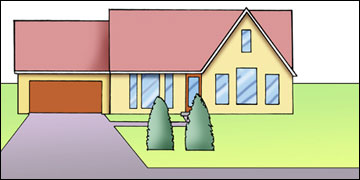
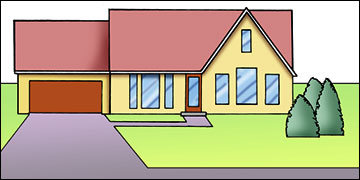 Figure 6
Figure 6
To increase the appearance of unity in a design, it is generally best to avoid pairing shrubs (top). Instead, place shrubs in odd-numbered groups of three or five.
Shrubs
Along with trees, shrubs form the basis of the front yard plantings. Strive for a mix of deciduous, broadleaf evergreen and coniferous to provide interest year-round, but avoid using too many different varieties. How and where shrubs are positioned strongly affects their appearance. Avoid "dotting" them about the lawn as this is visually distracting and makes lawn mowing much more difficult. Shrubs should be grouped together in beds or borders to maximize their effect. This grouping, or "massing" as it is often called, adds to the unity and improves the flow of the landscape. As plants merge together, the eye travels through the landscape more easily.
Once again, consider the mature size of the shrubs when planting. You want the plants to create a good mass without being overcrowded. Place shrubs so that they begin to merge together when they are approximately 70 percent of their mature size. Consult gardening books or a local nursery if you are unsure of mature size.
To improve the balance and appearance of massing, plant shrubs in odd numbers, such as three and five. Unless you are establishing a formal and symmetrical design, even numbers (such as two or four) tend to lessen the unity of the planting by visually splitting the eye. Adding a third or fifth plant causes the grouping to be viewed as a single mass. This is less important as the number of plants in a group gets larger, because the eye can no longer easily discern the number of plants in the grouping (Figure 6).
Also, if you are aiming for an informal look, consider staggering the shrubs rather than placing them in a straight line. Staggering creates a more flowing appearance than a rigid row of plants and also enhances the effect of massing, making it more solid.
Hedges
Hedges are a special use of trees or shrubs, and one that requires particular thought and placement. If a hedge is desired for the front yard, determine its function. Hedges can be used to establish a boundary, provide privacy or screen an objectionable view. Consider how much maintenance different hedging plants will need. Clipped hedges create a formal appearance and require regular maintenance. Unclipped hedges are more informal but can easily look unkempt.
For safety, any grouping of plants, whether informal masses or hedges should stop 15 to 20 feet from the edge of the street. Plants placed closer than this distance to the street can block the driver's view of the street from the car.
Lawn
The lawn, while not an essential feature for the front yard, does function to connect all the landscaping elements. A well-maintained lawn can contribute to the overall curb appeal of the property. If a lawn is desired, its shape should be planned along with the rest of the landscape. The lawn should have a well-defined and simple shape. For ease of mowing, edges should be uncomplicated; curves are the easiest to mow along. The lawn should be as free as possible from obstacles, including trees, boulders and birdbaths. Site these within planted beds or borders. Also, lawn is not a good choice for the shady areas below trees or on steep slopes. Ground cover looks better and is easier to maintain in these areas.
Ground cover
Ground cover, spreading plants that grow to a maximum height of 1 foot, can be used in conjunction with the lawn or can serve as a lawn substitute. A bed of ground cover planted next to an area of lawn or pavement can imply an edge to the space. A continuous flow of ground cover can unify separate planting areas and help the eye flow easily through the landscape. For information on selecting ground covers, see MU publication G6835, Selected Ground Covers for Missouri.
Flowers
Flowers — whether perennials, annuals or bulbs — are often the most desired and the least effective in establishing curb appeal. As with any other type of plant, flowers call for careful placement within the landscape. Unless your house is truly an old-fashioned cottage and you are an avid gardener, the idyllic cottage garden filled with an exuberance of flowering plants is not a good idea. Most perennials do not have a long bloom period and so are fairly uninteresting for the majority of the growing season and are totally absent in the winter. Annuals bloom longer through the summer months, but again, disappear with cold weather. Spring-flowering bulbs provide welcome spots of color after a long winter, but are by nature ephemeral and the dying foliage unattractive. They are better planted in the less public area of the property.
Used with restraint, flowers can be effective when planted at the foot of shrubs within borders (do not dot flowers between shrubs), or in containers near the entryway. The main purpose of flowers in the front yard should be to add a bit of color and interest. Choose a simple color scheme and keep to it. Two or three coordinating or contrasting colors are much more effective than a riot of color.
Flowers should not be the dominant feature of the landscaping. Do not scatter flowerbeds in the lawn and do not use flowers to line the driveway. Beds in the lawn distract the attention from the intended focal point — the front door, and flowers (or any other plants) lining the drive call too much visual attention to the garage door. Consider flowers as the extra touch, an embellishment, rather than as an essential element in the design. Perhaps their best use is as space fillers while newly planted shrubs are growing to mature size.
Structural materials
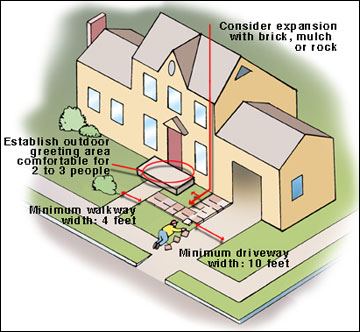 Figure 7
Figure 7
To accommodate foot traffic near a driveway, try expanding the area with a material different than that used for the driveway.
The two most basic hardscaping elements are the driveway and the entry walk, both usually paved surfaces. If you are working with an existing house and yard, make sure you position these two elements accurately on your base plan. Then evaluate whether the drive and walk are serving their purpose effectively. If you are building a new house, consider the following general guidelines.
The primary purpose of the driveway, obviously, is to provide space for car parking. The minimum functional width for a one-car drive is 10 feet. Consider if there is a need to expand the parking area. If the driveway also functions as the walk from the road to the front door, the drive should be widened by at least 3 feet. Without the extra width, there is little room to walk when a car is parked on the drive. This forces people to walk around the car along the narrow edge or to step onto the adjacent lawn or planted area. A simple widening of the drive with a different paving material identifies that area as a pedestrian path and facilitates foot traffic to the entry (Figure 7).
When separate from the driveway, the entry walk provides access from the road or the driveway to the front door. It has three main functions:
- Providing a safe approach
- Guiding people through the landscape
- Influencing their view
Many entry walks are poorly designed and so do not function effectively.
One of the most common problems is an entry walk that is too narrow. Typically, walks are only 3 feet wide, which forces people to walk single-file. To accommodate two people walking side-by-side, the walk must be at least 4 feet wide. Wheelchair access requires a width of 5 feet.
A related problem is the overgrown walk. Shrubs planted too close to the walk can reduce the available width and eventually cover the walk entirely. As in the selection of plant materials elsewhere in the landscape, mature size must be considered when positioning plants in relation to the entry walk.
Another problem is when an entry walk is not easily seen. This is particularly true where the walk connects to the driveway and there is nothing to indicate or call attention to the location of the walk. Thoughtful placement of plants can and should direct the eye to the entry route.
Visual interest is often lacking along the entry walk. An open expanse of lawn and a line of foundation plantings do not provide an especially stimulating view. The route to the front door can be developed so that it takes advantage of different views. The walk does not necessarily have to be a straight line. While the walk should be a direct one, a turn or two can add interest and allow you to vary the view on the way to the front door. Note, however, that there should be some physical reason for the path to curve, such as to go round a planting area or tree. Avoid purposeless curves, as they look artificial and without function.
The entry walk ends at the front door, often meeting a small concrete pad or stoop that serves as an outdoor foyer or greeting area. Typically, this space is too small to function well. It is so small that it does not allow people to stand on it while the storm or screen door is being opened without getting hit in the face or stepping away from the door. Consider enlarging this area of paving to accommodate at least two or three people comfortably.
It is also desirable to provide some type of protection from the elements. The overhead protection of a porch gives shelter from the rain. Also consider creating a feeling of semiprivacy at the entryway. A sense of enclosure can be provided by planting along the sides. However, be aware of plant sizes and positioning — do not make the mistake of screening the front door so that it is not visible from the road.
Paving materials
When choosing paving materials for the driveway, entry walk and greeting area, the two main factors to consider are cost and appearance. Concrete is the most commonly used material. While it is relatively inexpensive, it is rarely the most attractive option. Many different types of paving materials are available and can used to add distinction to the landscape and increase the curb appeal of the property.
Use the architectural character and building materials of your house to help you select appropriate paving materials. If your house is made of brick, stone or wood, try to incorporate the same materials in the landscape hardscaping. This increases the feeling of unity in the landscape.
Brick
Brick is an attractive paving option and can be used for all paved surfaces. Brick's color and texture impart a warm feeling to the landscape and is appropriate for both formal and informal styles. Bricks also add visual interest to the ground surface. They can be laid in any of several patterns or can be used in conjunction with other paving materials.
Manufactured pavers and tiles
Manufactured pavers and tiles can be used in the same way as brick and are usually a less expensive option. Pavers are readily available and some are quite attractive.
Stone
Stone is a good choice for foot traffic and is particularly well suited to an informal look. Many different types and categories of stone are available. For the most natural look, choose stone that is locally quarried or compatible in appearance with local stone. Stone is usually not a good choice for driveways unless it is cut very thick and laid on a stable base.
Wood
Wood has an appealing natural color and texture. It is best suited for walks and entry areas with an informal, rustic or modern character. Wood is a versatile material and can be stained or painted to blend in with house materials. Like stone, it is not suitable for drives.
Gravel, concrete and asphalt
Other paving options include gravel, concrete and asphalt. Gravel can be attractive and provides an interesting texture underfoot, but it must be contained with some type of edging material. Concrete can be a good choice for areas that are curvilinear or irregular since it conforms to any shape. Asphalt is too utilitarian to be used in the front yard if at all avoidable.
Slope
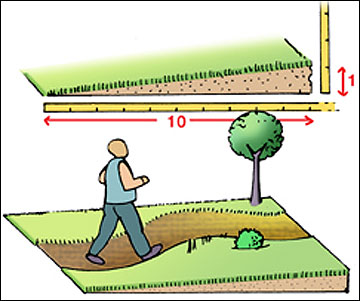 Figure 8
Figure 8
The maximum recommended slope in a residential landscape is 10 percent, or a change of not more than 1 foot in elevation over a horizontal distance of 10 feet.
There are a number of places on a residential site where you need to be sure that surface water drains properly. In the front yard, those areas are the house, the driveway, entry walk and greeting area. Water should always be directed away from the house so that it doesn't stand around the foundation. The recommended slope is anywhere between 1 percent and 10 percent (Figure 8).
On any paved surface where people or objects stand or walk, the water should be drained as quickly as possible so that the area can be used safely. Concrete and asphalt surfaces should have at least a 1 percent slope, while brick, stone and other rough pavement materials should have a minimum slope of 1.5 percent. At the same time, paved walks should not be steeper than a 5 percent slope, and driveways should not be steeper than 8 percent. The greeting area should not exceed 3 percent. Slopes beyond that percentage are perceived as having a definite slope and make a space feel unstable underfoot.
Other structural elements, such as fences and walls, may be used in the front yard. Along with plants, they can help establish boundaries, provide privacy, direct movement through the landscape or screen undesirable views. Additionally, retaining walls can make steeply sloped areas more usable. Freestanding walls and fences can be made of various materials, including stone, brick, wood, metal and concrete. Once again, the choice of hardscaping material should be made based on cost and appearance. Chain link fencing, while inexpensive and practical, is not an attractive choice for the front yard. Be aware that, like hedges and shrub borders, fences or walls should not come so close to the street that they block a driver's view (Figure 9).
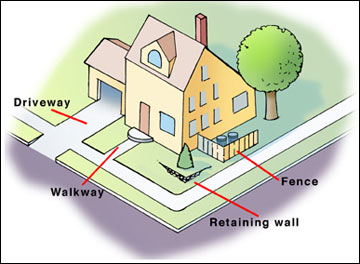 Figure 9
Figure 9
Structural elements such as fences and walls in a front yard should not obstruct a driver's view.
Accents and specimen plants
In general, accent features and specimen plants should be considered as embellishments and used with restraint or not at all. Items such as gazing balls, sundials, birdbaths, obelisks and statuary tend only to distract the eye and lessen the unity and balance of the front yard. If you enjoy such decorative items, they are more appropriately positioned in the private area of back yard.
A specimen plant is a tree or shrub used as a focal point due to its outstanding ornamental characteristics. By its very nature, such a plant draws attention to itself. The difficulty in using a specimen plant in the front yard is that it too easily becomes the primary focal point, drawing attention away from the front door. To avoid this, any specimen plant should be positioned near the door, so that the eye is led naturally from the plant to the door.
Do not use more than one specimen tree in the front garden. Two or more will compete with each other and the house. Also, choose a plant that is not overly dominant. For example, the Colorado blue spruce is one of the most popular specimen plants sold. While a healthy blue spruce looks perfectly at home in the Colorado landscape, its unusual color and strong pyramidal shape look out-of-place in most Missouri front yards. It is a strong accent and yet cannot be placed near the house or doorway because of its large size at maturity, so it inevitably disrupts the unity and balance of the landscape. A small tree or shrub with showy spring flowers or autumn color would be more appropriate and effective choice.
Summary
Remember, your front yard gives visitors their first impression of you and your home. By following the guidelines outlined above, you can create a landscape with strong curb appeal: one that is unified, balanced, in harmony with the house and the neighborhood and, at the same time, a unique reflection of you and your lifestyle.
 Figure 3
Figure 3